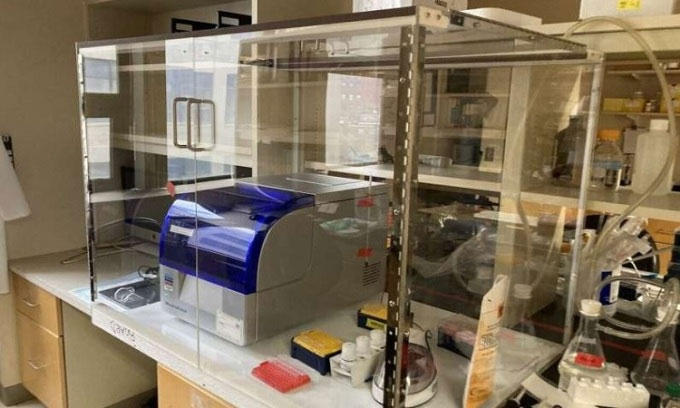A concentration meter developed by a research team at Brown University can detect the RNA of the novel coronavirus (nCoV) in the breath of infected individuals and in the air.
In a study published in the journal Molecular Diagnostics, scientists describe the design and testing of a concentration meter called Bubbler, which utilizes the virus’s RNA to diagnose Covid-19. The name of the product comes from the bubbling sound similar to a bubble popping when a patient breathes into the device.

The Bubble kit is processed in a negative pressure box to prevent contamination in the laboratory. (Photo: William G. Fairbrother)
The Bubbler not only reverses transcribes the RNA from viral particles in the air into DNA for testing via polymerase chain reaction (PCR) techniques but also generates a DNA barcode, enabling direct linking of the sample to the patient. The device can be used for multiple pooled samples at once, providing additional information such as viral load and strain identification, making home testing feasible.
The virus detection method of the Bubbler is similar to PCR tests using nasal-throat swabs in hospitals. However, this method is superior for controlling infection risk by detecting viral particles in the air. The Bubbler can also be adjusted to collect samples in environments such as hospitals, train stations, offices, ships, and airplanes.
Seventy patients treated in the Emergency Department at Rhode Island Hospital from May 2020 to January 2021 were screened in the study. Scientists collected samples from three points in the respiratory tract. Samples from the mouth (saliva/tongue) and from 15 seconds of exhalation through the Bubbler were compared with conventional nasal-throat swab samples from PCR tests. With the Bubbler, patients exhale through a small glass tube. This tube contains a reverse transcription reaction mixture and cold mineral oil.
The research team determined that nCoV could be detected in breath. The RNA of the virus in breath is more abundant than in the oral sample. Meanwhile, the oral sample contains cells related to the replication activity of nCoV, which are absent in breath. This indicates that the viral signals detected by the Bubbler come from active viral particles.
According to the lead researcher William G. Fairbrother, a professor in the Department of Molecular Biology, Cell Biology, and Biochemistry at Brown University in Providence, Rhode Island, another advantage of the Bubbler is its barcode feature, which allows for virus RNA testing at a significantly lower cost compared to conventional tests.
Researchers also demonstrated that the Bubbler can be adjusted to detect viruses in airborne samples. To model the movement of droplets expelled from human breath, three nucleic acid samples were added to a humidifier at three different distances from the Bubbler. The results reveal the potential of using nucleic acids to map airflow in indoor environments and detect nCoV in the air.


















































